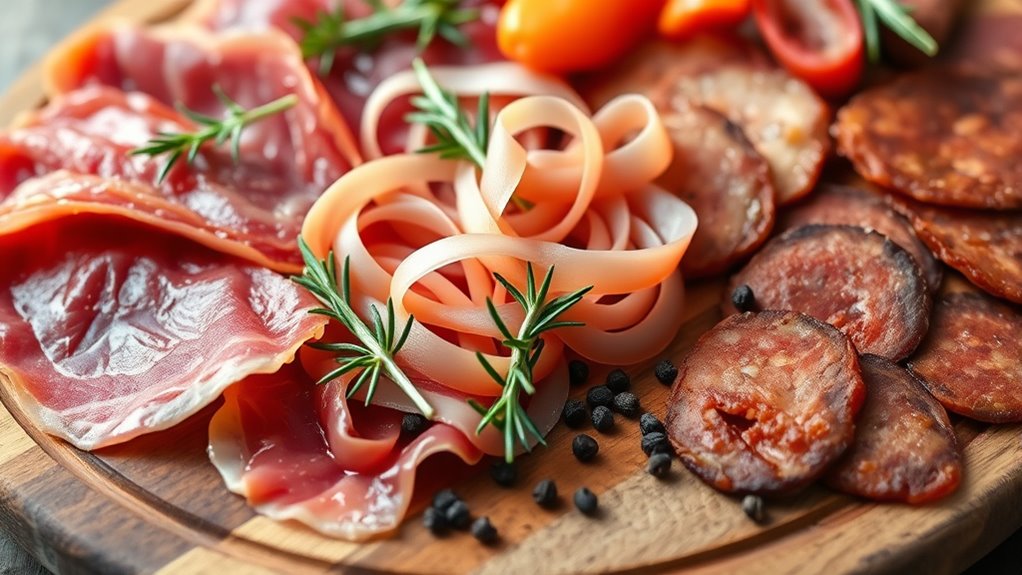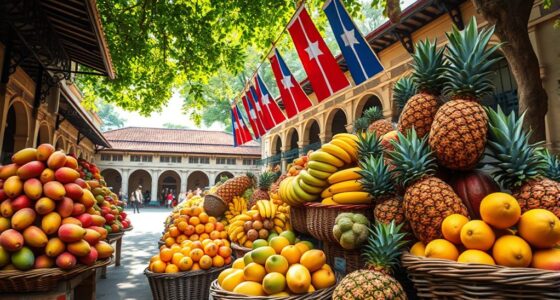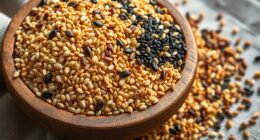Explore the art of charcuterie by discovering how regional influences shape cured meats. In France, you’ll find pâtés and rillettes with delicate seasonings, while Italy offers richly flavored salami and prosciutto through dry curing. Spain’s chorizo and jamón ibérico bring smoky depths, and Eastern Europe’s kielbasa features bold spices and smoking techniques. Climate and tradition deeply impact each style. If you continue, you’ll uncover the craftsmanship behind these delicious, diverse cured meats.
Key Takeaways
- Regional climate, ingredients, and traditions shape distinct charcuterie styles across France, Italy, Spain, and Eastern Europe.
- French charcuterie emphasizes delicate seasoning, smooth pâtés, and precise curing times for refined flavors.
- Italian charcuterie features dry-cured, aged products like salami and prosciutto, with regional ingredient influences.
- Spanish charcuterie highlights smoky, flavorful jamón ibérico and chorizo, often cured in caves with bold seasonings.
- Curing environments, including caves and cellars, play a vital role in developing texture and flavor in cured meats.

Charcuterie, the art of preserving and preparing cured meats, varies widely across regions, each offering unique flavors and techniques. As you explore this culinary world, you’ll discover how geography, climate, and local traditions shape the methods used to create these savory delights.
In France, for example, you might encounter pâtés and rillettes, which are smooth, spreadable meats often made from pork. French charcuterie emphasizes delicate seasoning and precise curing times, resulting in refined flavors that reflect the country’s sophisticated palate.
In Italy, salami and prosciutto are staples, showcasing a focus on dry curing and aging. You can taste the rich, complex flavors that develop through months of aging in controlled environments. Italian charcuterie often incorporates regional ingredients like fennel seeds, garlic, and wine, giving each product a distinct identity.
The process involves salting and fermenting the meat, which not only preserves it but also enhances its taste, texture, and aroma. As you try different varieties, you’ll notice how each region’s climate influences the humidity and temperature, impacting the final product’s flavor profile.
Moving to Spain, you’ll find chorizo and jamón ibérico, both renowned for their deep, smoky, and savory notes. Spanish cured meats are often made from Iberian pigs, which contribute to the richness and unique flavor characteristics.
The curing process is traditionally done in natural caves or cellars, where the cool, humid environment helps develop complex flavors over months or even years. Spanish charcuterie emphasizes bold seasonings like paprika, which gives chorizo its signature red hue and smoky flavor, and the slow curing process results in a melt-in-your-mouth texture.
In Eastern Europe, you’ll encounter varieties like kielbasa and smoked sausages, which often incorporate spices like allspice, garlic, and pepper. The methods here blend influences from neighboring regions, creating a robust, hearty flavor profile suited for colder climates.
The curing processes often involve smoking, which adds a distinctive smoky aroma and extends shelf life. These meats are integral to traditional dishes, and their preparation reflects a practical approach to preservation, ensuring you have flavorful protein sources during long winters.
Additionally, understanding the curing environment—such as temperature, humidity, and airflow—is essential, as it directly influences the development of flavor, aroma, and texture in cured meats. As you explore the world of charcuterie, you’ll see how each region’s techniques and ingredients create a tapestry of flavors. Understanding these differences enriches your appreciation and helps you recognize the craftsmanship behind each piece.
Whether you prefer the delicate French pâtés, the robust Spanish chorizo, or the aged Italian salami, you’ll find that each cured meat tells a story of its land, climate, and culinary history.
Frequently Asked Questions
How Do Regional Climates Affect Cured Meat Flavors?
Regional climates play a big role in shaping cured meat flavors. When you’re in a humid, warm climate, the meats tend to develop richer, more intense flavors because of quicker aging and higher microbial activity.
In cooler, drier areas, the flavors are often subtler and more refined. You’ll notice that climate influences everything from the texture to the aroma, giving each region’s cured meats a unique character.
What Are Traditional Tools Used in Regional Charcuterie Methods?
Imagine you’re a skilled musician, and your tools are your instruments. In regional charcuterie, traditional tools like wooden chopping blocks, handcrafted knives, and curing racks are your instruments. You use these to craft flavors, much like tuning an instrument.
These tools, passed down through generations, shape each cured meat’s unique character, connecting you to the land and history behind the recipes. Your craftsmanship begins with these essential, time-honored implements.
How Do Curing Techniques Differ Between Regions?
You’ll notice curing techniques vary widely between regions. In Italy, you might use salt and air drying for prosciutto, emphasizing slow aging in cool, dry environments.
In Spain, curing often involves paprika and garlic for chorizo, with some areas using smoke.
France might incorporate herbs and wine, focusing on flavor complexity.
These regional differences reflect local climate, ingredients, and cultural traditions, shaping each unique cured meat.
Which Meats Are Most Commonly Used in Regional Charcuterie?
You’ll find that regional charcuterie often features popular meats like pork, beef, and lamb. Pork is most common, with varieties like ham, sausages, and pâtés, especially in European cuisines.
In some regions, you might also see beef cured as bresaola or biltong.
Lamb is featured in specialties like Cyprus’ soutzoukos.
Your choices depend on local traditions, climate, and available ingredients, making each region’s charcuterie uniquely delicious.
How Are Regional Spices Incorporated Into Cured Meats?
You can incorporate regional spices into cured meats by experimenting with local herbs and seasonings, which complement the regional flavors. For example, you might add fennel seeds in Italy or paprika in Hungary to enhance the meat’s profile.
You simply rub or marinate the meats with these spices before curing, allowing the flavors to meld over time. This technique creates authentic regional tastes, making each cured meat uniquely reflective of its origins.
Conclusion
As you explore the world of charcuterie, you realize that each region’s cured meats reflect its history and climate. Some say the unique flavors develop due to local microbes, a theory supported by the distinct tastes across regions. By tasting these meats, you not only savor tradition but also witness how geography influences culinary artistry. So, next time you indulge, remember you’re experiencing a delicious piece of history shaped by nature and culture.








